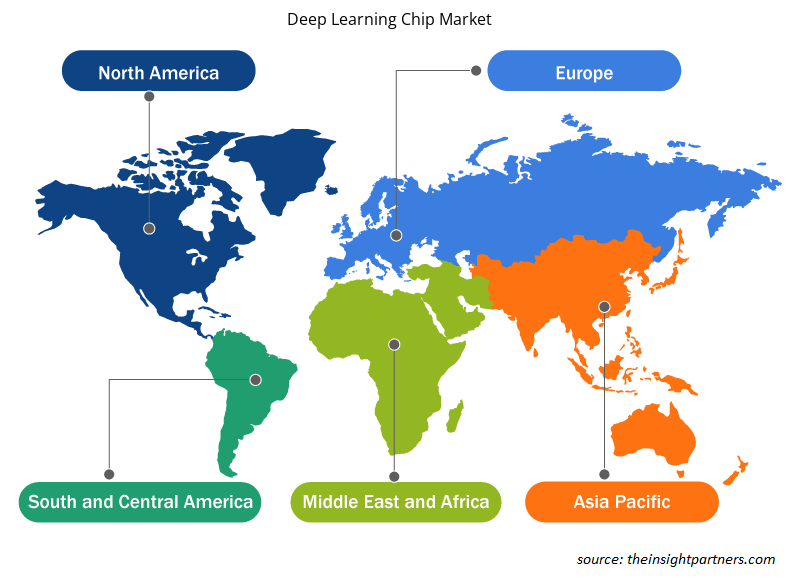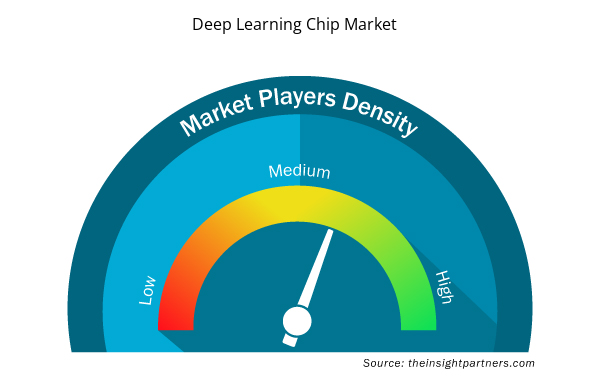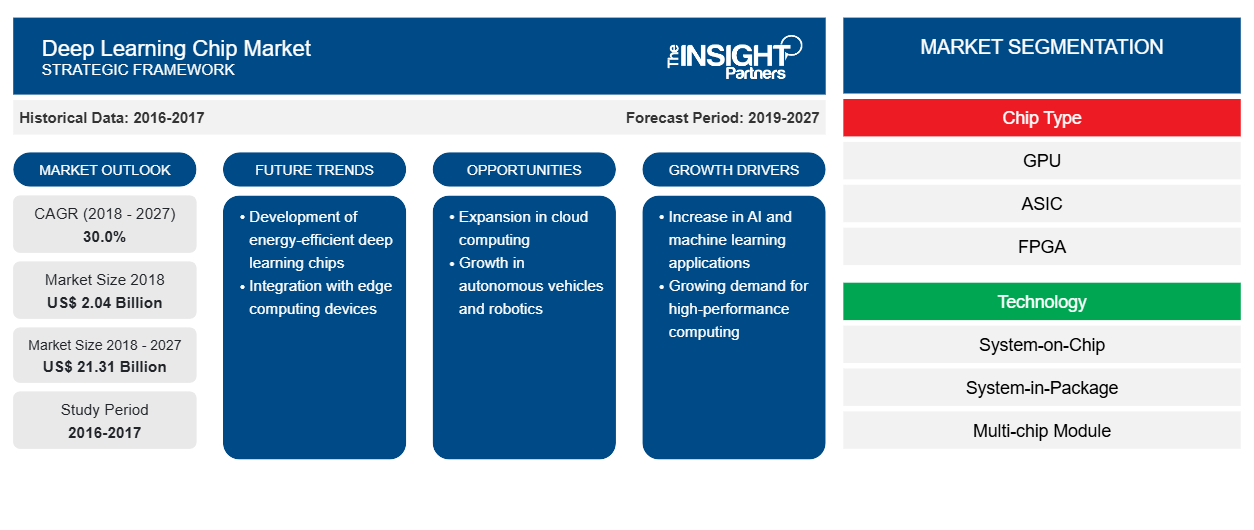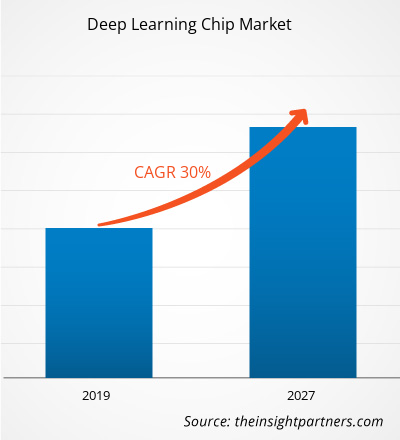Der globale Markt für Deep-Learning-Chips belief sich im Jahr 2018 auf 2,04 Milliarden US-Dollar und dürfte im Prognosezeitraum 2019–2027 mit einer durchschnittlichen jährlichen Wachstumsrate von 30,0 % wachsen und bis 2027 einen Wert von 21,31 Milliarden US-Dollar erreichen.
Nordamerika ist weltweit führend auf dem Markt für Deep-Learning-Chips und wird voraussichtlich im gesamten Prognosezeitraum den größten Umsatzbeitrag leisten. Die Entwicklung von Deep-Learning-Chips wird durch umfangreiche Investitionen von Technologiegiganten unterstützt, um aus einer riesigen Menge generierter Daten Muster zu entwickeln. Der Aufstieg des Quantencomputings und die Implementierung von Deep-Learning-Chips in der Robotik treiben das Wachstum des Marktes für Deep-Learning-Chips in den nordamerikanischen Ländern voran.
Markteinblicke
Die Bedeutung des Quantencomputings trägt zum Wachstum des Marktes für Deep-Learning-Chips bei
Quantencomputer benötigen nur Sekunden, um eine Berechnung abzuschließen, die sonst mehr Zeit in Anspruch nehmen würde. Quantencomputer sind eine innovative Transformation von künstlicher Intelligenz, maschinellem Lernen und Big Data. Daher wird erwartet, dass die Bedeutung des Quantencomputers das Wachstum des Marktes für Deep-Learning-Chips vorantreiben wird. Darüber hinaus ist Quantencomputer für verschiedene Faktoren von Vorteil, darunter Portfoliooptimierung, Betrugserkennung und Risikomanagement sowie für Bereiche, in denen sofortiges Datenfeedback erforderlich ist. Daher ist es für einen einzelnen Prozessor einfacher, komplexe Berechnungen in Sekundenschnelle durchzuführen. Darüber hinaus hilft Deep Learning angesichts der Größe und des Umfangs des Internets dabei , große Datensätze zu sehr geringen Kosten zu verwalten. Daher wird erwartet, dass diese Faktoren das Wachstum des globalen Marktes für Deep-Learning-Chips ankurbeln werden.
Passen Sie diesen Bericht Ihren Anforderungen an
Sie erhalten kostenlose Anpassungen an jedem Bericht, einschließlich Teilen dieses Berichts oder einer Analyse auf Länderebene, eines Excel-Datenpakets sowie tolle Angebote und Rabatte für Start-ups und Universitäten.
- Holen Sie sich die wichtigsten Markttrends aus diesem Bericht.Dieses KOSTENLOSE Beispiel umfasst eine Datenanalyse von Markttrends bis hin zu Schätzungen und Prognosen.
Einblicke in das Verbraucherverhalten in Echtzeit und erhöhte Betriebseffizienz treiben das Gesamtwachstum des Marktes für Deep-Learning-Chips voran
Die Geschäftswelt wird zunehmend wettbewerbsorientierter und um effizient konkurrieren zu können, verlassen sich Unternehmen heutzutage auf nützliche Informationen und Geschäftsanalysen. Traditionell wurden Geschäftsanalysetools verwendet, um den Umsatz anhand von Daten zu Ereignissen zu prognostizieren, die eine Woche oder einen Monat alt waren. Mit dem Aufkommen der künstlichen Intelligenz, die in Echtzeit lernt und auf Mustern basierende Empfehlungen liefert, haben Unternehmen eine enorme Chance, Deep Learning in verschiedenen Prozessen anzuwenden, um das Geschäftsumfeld und die Kunden besser zu verstehen.
Unter Berücksichtigung dieser Faktoren ermöglicht künstliche Intelligenz Unternehmen, die Betriebseffizienz zu steigern, die Betriebskosten zu senken sowie die Servicequalität und das Kundenerlebnis zu verbessern.
Einblicke in Chiptypen
Grafikprozessoren (GPUs) hatten 2018 den größten Marktanteil bei Deep-Learning-Chips, während anwendungsspezifische integrierte Schaltkreise (ASICs) im Prognosezeitraum voraussichtlich das am schnellsten wachsende Segment sein werden. Aufgrund der Tatsache, dass ASICs sehr spezifisch und weniger flexibel sind, sind sie eine der leistungsstärksten verfügbaren Hardwareoptionen für Anwendungen der künstlichen Intelligenz.
Technologieeinblicke
Zu den Deep-Learning-Chipsätzen gehören System-on-Chip, System-in-Package, Multi-Chip-Module und andere Chipsätze. Das System-on-Chip-Segment hatte 2018 den größten Marktanteil bei Deep-Learning-Chips, da es dazu beiträgt, Energieverschwendung, den Platzbedarf der großen Systeme und die Kosten zu reduzieren.
Einblicke in die vertikale Branche
Der globale Markt für Deep-Learning-Chips ist in die Bereiche BFSI, Einzelhandel, IT & Telekommunikation, Automobil & Transport, Gesundheitswesen, Medien & Unterhaltung und Sonstige unterteilt. BFSI hielt den größten Marktanteil auf dem Markt für Deep-Learning-Chips, während das Gesundheitswesen voraussichtlich das am schnellsten wachsende Segment auf dem Markt sein wird. Faktoren wie die Senkung der Betriebskosten, die Anpassung an sich ändernde Vorschriften und Bestimmungen, die Konzentration auf das Kerngeschäft und die Integration der Automatisierung in Geschäftsprozesse sind weitere wichtige Faktoren, die das Wachstum des BFSI-Segments auf dem Markt für Deep-Learning-Chips vorantreiben.
Die Marktteilnehmer auf dem Markt für Deep-Learning-Chips konzentrieren sich hauptsächlich auf Produktverbesserungen durch die Implementierung fortschrittlicher Technologien. Durch den Abschluss von Partnerschaften, Verträgen, Joint Ventures, Finanzierungen und die Eröffnung neuer Niederlassungen auf der ganzen Welt kann das Unternehmen seinen Markennamen weltweit aufrechterhalten. Einige der jüngsten Entwicklungen sind unten aufgeführt:
2019: NVIDIA hat in Zusammenarbeit mit Hackster.io die AI at the Edge Challenge ins Leben gerufen, einen Wettbewerb, bei dem Entwickler das NVIDIA Jetson Nano Developer Kit zum Erstellen kreativer und einzigartiger Projekte nutzen und die Chance haben, Preise im Wert von 100.000 US-Dollar zu gewinnen.
2019: Intel gab seine Pläne bekannt, die Fabrik in Oregon zu erweitern, um einen 7-nm-Chip herzustellen. Intels neue Fabrik wird die dritte Phase von D1X sein, einer riesigen Fabrik, die Intel 2010 begann. Jede der ersten beiden Phasen war 1,1 Millionen Quadratfuß groß, wodurch eine kombinierte Anlage entstand, die 15 Costco-Lagerhäusern entspricht. Die dritte Phase wird die Produktionsfläche von D1X offenbar um etwa 50 Prozent vergrößern. Darüber hinaus sagt Intel, dass die Fabrikerweiterung es dem Unternehmen ermöglichen wird, 60 Prozent schneller auf Chip-Engpässe zu reagieren.
2019: Huawei bringt HiSecEngine USG12000 auf den Markt, die branchenweit erste AIFW der T-Stufe. Die HiSecEngine USG12000 ist mit Ascend AI-Chips ausgestattet, die intelligente Erkennungsfunktionen sowie eine intelligente Grenzverteidigung für Unternehmensnetzwerke bieten.
Regionale Einblicke in den Markt für Deep-Learning-Chips
Die regionalen Trends und Faktoren, die den Markt für Deep-Learning-Chips im Prognosezeitraum beeinflussen, wurden von den Analysten von Insight Partners ausführlich erläutert. In diesem Abschnitt werden auch die Marktsegmente und die Geografie von Deep-Learning-Chips in Nordamerika, Europa, im asiatisch-pazifischen Raum, im Nahen Osten und Afrika sowie in Süd- und Mittelamerika erörtert.

- Erhalten Sie regionale Daten zum Markt für Deep-Learning-Chips
Umfang des Marktberichts zu Deep-Learning-Chips
| Berichtsattribut | Details |
|---|---|
| Marktgröße im Jahr 2018 | 2,04 Milliarden US-Dollar |
| Marktgröße bis 2027 | 21,31 Milliarden US-Dollar |
| Globale CAGR (2018 - 2027) | 30,0 % |
| Historische Daten | 2016-2017 |
| Prognosezeitraum | 2019–2027 |
| Abgedeckte Segmente | Nach Chiptyp
|
| Abgedeckte Regionen und Länder | Nordamerika
|
| Marktführer und wichtige Unternehmensprofile |
|
Marktteilnehmerdichte: Der Einfluss auf die Geschäftsdynamik
Der Markt für Deep-Learning-Chips wächst rasant. Dies wird durch die steigende Nachfrage der Endnutzer aufgrund von Faktoren wie sich entwickelnden Verbraucherpräferenzen, technologischen Fortschritten und einem größeren Bewusstsein für die Vorteile des Produkts vorangetrieben. Mit der steigenden Nachfrage erweitern Unternehmen ihr Angebot, entwickeln Innovationen, um die Bedürfnisse der Verbraucher zu erfüllen, und nutzen neue Trends, was das Marktwachstum weiter ankurbelt.
Die Marktteilnehmerdichte bezieht sich auf die Verteilung der Firmen oder Unternehmen, die in einem bestimmten Markt oder einer bestimmten Branche tätig sind. Sie gibt an, wie viele Wettbewerber (Marktteilnehmer) in einem bestimmten Marktraum im Verhältnis zu seiner Größe oder seinem gesamten Marktwert präsent sind.
Die wichtigsten auf dem Markt für Deep-Learning-Chips tätigen Unternehmen sind:
- Weitere Informationen finden Sie unter: Advanced Micro Devices, Inc.
- Alphabet Inc. (Google)
- Amazon.com, Inc.
- Baidu, Inc.
- Huawei Technologies Co., Ltd
Haftungsausschluss : Die oben aufgeführten Unternehmen sind nicht in einer bestimmten Reihenfolge aufgeführt.

- Überblick über die wichtigsten Akteure auf dem Markt für Deep-Learning-Chips
GLOBALE SEGMENTIERUNG DES DEEP-LEARING-CHIP-MARKTES
Nach Chiptyp
- Grafikkarte
- ASIC
- FPGA
- CPU
- Sonstiges
Nach Technologie
- System-on-Chip
- System-in-Package
- Multi-Chip-Modul
- Sonstiges
Nach Branchenvertikale
- Medien & Werbung
- BFSI, IT und Telekommunikation
- Einzelhandel
- Gesundheitspflege
- Automobil und Transport
- Sonstiges
Nach Geografie
Nordamerika
- UNS
- Kanada
- Mexiko
Europa
- Frankreich
- Deutschland
- Vereinigtes Königreich
- Russland
- Italien
- Restliches Europa
Asien-Pazifik (APAC)
- Australien
- China
- Indien
- Japan
- Südkorea
- Restlicher Asien-Pazifik-Raum
Naher Osten und Afrika (MEA)
- Saudi-Arabien
- Südafrika
- Vereinigte Arabische Emirate
- Rest von MEA
Südamerika (SAM)
- Brasilien
- Argentinien
- Rest von SAM
Firmenprofile
- Weitere Informationen finden Sie unter: Advanced Micro Devices, Inc.
- Alphabet Inc. (Google)
- Amazon.com, Inc.
- Baidu, Inc.
- Huawei Technologies Co., Ltd
- Intel Corporation
- NVIDIA Corporation
- Qualcomm Incorporated
- Samsung Electronics Co., Ltd.
- Xilinx, Inc.
- Historische Analyse (2 Jahre), Basisjahr, Prognose (7 Jahre) mit CAGR
- PEST- und SWOT-Analyse
- Marktgröße Wert/Volumen – Global, Regional, Land
- Branche und Wettbewerbsumfeld
- Excel-Datensatz


- Integrated Platform Management System Market
- Quantitative Structure-Activity Relationship (QSAR) Market
- Cosmetic Bioactive Ingredients Market
- Animal Genetics Market
- Organoids Market
- Adaptive Traffic Control System Market
- Portable Power Station Market
- Data Center Cooling Market
- Europe Tortilla Market
- Thermal Energy Storage Market

Report Coverage
Revenue forecast, Company Analysis, Industry landscape, Growth factors, and Trends

Segment Covered
This text is related
to segments covered.

Regional Scope
North America, Europe, Asia Pacific, Middle East & Africa, South & Central America

Country Scope
This text is related
to country scope.
Häufig gestellte Fragen
The BFSI industry dominated the deep learning chip market in the year 2018. Banking, financial services, and insurance (BFSI) industries have great potential for deep learning chips due to the presence of huge financial and personal data of customers. In this sector, a high amount of sensitive data is generated and exchanged every day. There is growing volume and creation of endpoints and mobile devices in banks, credit card companies, and credit reporting institutions, thus, it becomes important for these industry verticals to harness this data to gain insights about various business aspects.
Presently, the major applications of deep learning chips are in the data center/cloud computing segment, and this trend is expected to continue during the forecast period. Also, majorly due to rising adoption of AI in developing regions, evolving architectures of deep learning chips and increasing applications across various industry verticals. Owing to this growing trend, the companies are anticipated to produce high-quality service by adopting cloud-based artificial intelligence services.
North America is one of the fastest-growing regions in terms of technological development. In the past 3 years, the region witnessed significant adoption of AI solutions across all the sectors. North America contributes the largest market share in terms of revenue, and it is estimated that it will continue its dominance in the market share during the forecast period. Deep learning chip development is backed by large-scale investment from technological giants to develop patterns from huge amount of generated data. The rise of quantum computing and implementation of deep learning chips in robotics drive the growth of the deep learning chip market in the North American countries.
Trends and growth analysis reports related to Electronics and Semiconductor : READ MORE..
The List of Companies - Deep Learning Chip Market
- Advanced Micro Devices, Inc.
- Alphabet Inc. (Google)
- Amazon.com, Inc.
- Baidu, Inc.
- Huawei Technologies Co., Ltd
- Intel Corporation
- NVIDIA Corporation
- Qualcomm Incorporated
- Samsung Electronics Co., Ltd.
- Xilinx, Inc.
The Insight Partners performs research in 4 major stages: Data Collection & Secondary Research, Primary Research, Data Analysis and Data Triangulation & Final Review.
- Data Collection and Secondary Research:
As a market research and consulting firm operating from a decade, we have published and advised several client across the globe. First step for any study will start with an assessment of currently available data and insights from existing reports. Further, historical and current market information is collected from Investor Presentations, Annual Reports, SEC Filings, etc., and other information related to company’s performance and market positioning are gathered from Paid Databases (Factiva, Hoovers, and Reuters) and various other publications available in public domain.
Several associations trade associates, technical forums, institutes, societies and organization are accessed to gain technical as well as market related insights through their publications such as research papers, blogs and press releases related to the studies are referred to get cues about the market. Further, white papers, journals, magazines, and other news articles published in last 3 years are scrutinized and analyzed to understand the current market trends.
- Primary Research:
The primarily interview analysis comprise of data obtained from industry participants interview and answers to survey questions gathered by in-house primary team.
For primary research, interviews are conducted with industry experts/CEOs/Marketing Managers/VPs/Subject Matter Experts from both demand and supply side to get a 360-degree view of the market. The primary team conducts several interviews based on the complexity of the markets to understand the various market trends and dynamics which makes research more credible and precise.
A typical research interview fulfils the following functions:
- Provides first-hand information on the market size, market trends, growth trends, competitive landscape, and outlook
- Validates and strengthens in-house secondary research findings
- Develops the analysis team’s expertise and market understanding
Primary research involves email interactions and telephone interviews for each market, category, segment, and sub-segment across geographies. The participants who typically take part in such a process include, but are not limited to:
- Industry participants: VPs, business development managers, market intelligence managers and national sales managers
- Outside experts: Valuation experts, research analysts and key opinion leaders specializing in the electronics and semiconductor industry.
Below is the breakup of our primary respondents by company, designation, and region:

Once we receive the confirmation from primary research sources or primary respondents, we finalize the base year market estimation and forecast the data as per the macroeconomic and microeconomic factors assessed during data collection.
- Data Analysis:
Once data is validated through both secondary as well as primary respondents, we finalize the market estimations by hypothesis formulation and factor analysis at regional and country level.
- Macro-Economic Factor Analysis:
We analyse macroeconomic indicators such the gross domestic product (GDP), increase in the demand for goods and services across industries, technological advancement, regional economic growth, governmental policies, the influence of COVID-19, PEST analysis, and other aspects. This analysis aids in setting benchmarks for various nations/regions and approximating market splits. Additionally, the general trend of the aforementioned components aid in determining the market's development possibilities.
- Country Level Data:
Various factors that are especially aligned to the country are taken into account to determine the market size for a certain area and country, including the presence of vendors, such as headquarters and offices, the country's GDP, demand patterns, and industry growth. To comprehend the market dynamics for the nation, a number of growth variables, inhibitors, application areas, and current market trends are researched. The aforementioned elements aid in determining the country's overall market's growth potential.
- Company Profile:
The “Table of Contents” is formulated by listing and analyzing more than 25 - 30 companies operating in the market ecosystem across geographies. However, we profile only 10 companies as a standard practice in our syndicate reports. These 10 companies comprise leading, emerging, and regional players. Nonetheless, our analysis is not restricted to the 10 listed companies, we also analyze other companies present in the market to develop a holistic view and understand the prevailing trends. The “Company Profiles” section in the report covers key facts, business description, products & services, financial information, SWOT analysis, and key developments. The financial information presented is extracted from the annual reports and official documents of the publicly listed companies. Upon collecting the information for the sections of respective companies, we verify them via various primary sources and then compile the data in respective company profiles. The company level information helps us in deriving the base number as well as in forecasting the market size.
- Developing Base Number:
Aggregation of sales statistics (2020-2022) and macro-economic factor, and other secondary and primary research insights are utilized to arrive at base number and related market shares for 2022. The data gaps are identified in this step and relevant market data is analyzed, collected from paid primary interviews or databases. On finalizing the base year market size, forecasts are developed on the basis of macro-economic, industry and market growth factors and company level analysis.
- Data Triangulation and Final Review:
The market findings and base year market size calculations are validated from supply as well as demand side. Demand side validations are based on macro-economic factor analysis and benchmarks for respective regions and countries. In case of supply side validations, revenues of major companies are estimated (in case not available) based on industry benchmark, approximate number of employees, product portfolio, and primary interviews revenues are gathered. Further revenue from target product/service segment is assessed to avoid overshooting of market statistics. In case of heavy deviations between supply and demand side values, all thes steps are repeated to achieve synchronization.
We follow an iterative model, wherein we share our research findings with Subject Matter Experts (SME’s) and Key Opinion Leaders (KOLs) until consensus view of the market is not formulated – this model negates any drastic deviation in the opinions of experts. Only validated and universally acceptable research findings are quoted in our reports.
We have important check points that we use to validate our research findings – which we call – data triangulation, where we validate the information, we generate from secondary sources with primary interviews and then we re-validate with our internal data bases and Subject matter experts. This comprehensive model enables us to deliver high quality, reliable data in shortest possible time.


 Holen Sie sich ein kostenloses Muster für diesen Bericht
Holen Sie sich ein kostenloses Muster für diesen Bericht